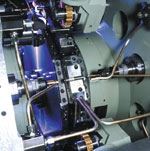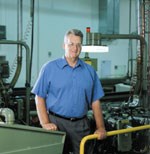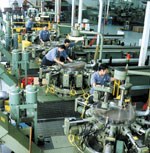Why Using The Latest Technology Simply Isn't Enough
Suppliers to the automotive industry know they've got to be competitive, have consistent, repeatable quality and deliver on time, every time. Often having the latest technology is a crucial competitive advantage. But sometimes having and using the latest equipment isn't enough. Here's why.
Share


Autodesk, Inc.
Featured Content
View More
ECi Software Solutions, Inc.
Featured Content
View More



Ian Barrie, president, Advance Precision, is meticulous in discussing the range of issues affecting competitiveness as an automotive supplier. Mr. Barrie, who spent 20 years inside the industry, knows something about what is expected, as well as its somewhat unpredictable nature.
According to Mr. Barrie, a major competitive driver is the technology one selects. "Early on, our parent company, General Kinetics, made the decision to go 100 percent automotive," he says. "The company was already machining automotive parts and recognized a potential for substantial growth. It carved out an aggressive strategy to tether its growth and success to its automotive customers."
General Kinetics knew, however, that it would need an advantage to succeed in a business that was heavily populated by established screw machine houses. It chose to concentrate on fully optimizing rotary transfer technology.
The first machine, a Hydromat, was delivered in 1994. By 1998, General Kinetics had added seven more machines. In 1999, the automotive business was spun off as a separate company, Advance Precision, as was the remaining division of General Kinetics, General Kinetics Engineering, a manufacturer of shock absorbers for off-road military applications—tanks, howitzers and other heavy-duty equipment.
"When we moved into this 26,000-square foot facility in August 1999, we had seven rotary transfer machines," Mr. Barrie says. "Today, we have 11, both rotary transfer and trunnion types, with one more of each on order. The growth that was anticipated back in 1994 is indeed happening. We now run three shifts, five days a week, totaling 120 hours, making seat belt and air conditioning components. We've enough space for 20 rotary transfer machines, and we feel that's a good marginal size for a plant—20 machines, three shifts, five days a week."
Mr. Barrie suggests that there are no plans to dilute the technology stable. "We've focussed on a single technology, and we don't see any advantage to bringing variables into our manufacturing strategy. What we do intend is to exploit fully the technology we have," he says.
Variables Outside Control
As an automotive supplier, Mr. Barrie finds himself literally in the middle of the flow of supply and demand, a flow that is often outside his control. On the one hand, trying to anticipate the automotive sector's needs is very difficult. "We're near the end of the chain in terms of the build cycle," he says, "and we get sourced relatively late. As a consequence, our inventory fluctuations are quite steep. Some months our customers will think they've got plenty of parts, and they'll reduce orders. Then, they'll work a couple of days overtime and suddenly need more parts, right now. We're working on systems that will let us deal with these swings without having to rely on buffered inventories." On the other hand, those who supply Mr. Barrie with raw materials (steel, aluminum, brass) create another balancing act. For example, certain steels may have a five-to six-month delivery window, creating a problem trying to align raw material availability with anticipated customer demand. A similar situation exists in sourcing cutting tools. In this case, it's getting suppliers to deliver good perishable tools where they're needed, when they're needed. The operative word here is "good" in that the tools must be consistent. Putting inconsistent tools on a rotary transfer machine results in stopping and adjusting every time a tool is changed which, in turn, leads to unnecessary downtime.
"We're trying to address these issues by consolidating purchasing to single-source providers," Mr. Barrie says. "We're hoping to build enough muscle to make our suppliers sit up and take notice and perhaps address our needs differently. Our customers expect us to deliver quality at a fair price and on time. They don't want to carry our inventory, nor do we wish to carry more supplier inventory than we need."
Competitive Edges
Precision rotary transfer machine technology provides Advance Precision with a number of advantages: one is consistent part quality. Mr. Barrie points out that most of the parts that Advance Precision makes are processed automatically—in bowl feeders or automated assembly systems. Thus, consistent part quality, batch to batch, is critical. "Our parts have to be exactly the same, every time, which allows our customers to process parts without fear that an inconsistent part will shut down their automation," he says.
Another advantage relates to cost. The ability to produce parts at a lower cost than might be achieved by other processes is a real strength. However, Mr. Barrie concedes he's really not competitive if a part can be made on a conventional screw machine in one operation, finished and shipped. If a part requires two or three secondary operations—even a single secondary operation—then Advance Precision becomes very competitive.
"Parts that come off screw machines and need two, three or four secondary operations, or are made by CNC or some other process, is where we're very strong," he says. "Single fixturing gives us consistent repeatability. There's no refixturing or handling to throw parts out of tolerance. Further, the longest cycle time of a given single station becomes the net cycle time for the entire process, whereas in CNC the cycle time is an accumulation of every operation."
Mr. Barrie uses a 3 1/2-inch long part as an example. The part requires a through-hole. On the rotary transfer machine, the hole can be drilled in four stations at a cycle time of about 6 seconds. If the same hole had to be drilled in a single operation, the cycle time would be 12 to 14 seconds. Due to this flexibility and repeatability, Mr. Barrie says he can build a part a number of ways, selecting the sequences that deliver the best cycle time and the highest productivity. "The key to making these parts—to being competitive—is learning how to fully exploit the technology at hand."
A "Sensible" Machining Strategy
Clearly, tying technology to an overall manufacturing/machining strategy (one that addresses goals, provides continuous improvement and results in growth) is just good business. In Mr. Barrie's case such a strategy must also make "sense."
"We've developed a machining strategy that allows us to operate within the scope of our manufacturing capability," Mr. Barrie says. "What we try to do is to only produce parts that fall well within that capability, and then raise our capability to higher levels through continuous improvement. So, we're not running at the upper limit or pushing the envelope—that would require constant rethinking, changing, process reinvention. The result would be lower productivity, longer cycle times, more scrap, higher inventories and so on. So, we select parts that fall within our comfort zone, and these are primarily families of parts with high volumes."
A family of parts can be defined as those that can be produced with the same machine units. The idea is to keep such a family on the same machine, thereby reducing the down time associated with machine changeover. An example of the part-family strategy is having one part run on three machines, another run on two machines and three parts on one machine—all the time.
"We run 60 percent steel, 35 percent aluminum and 5 percent brass," Mr. Barrie says. "The steels are 12L14, 12L15, 1144 stress-proof and 1144 fatigue-proof. Every part is of a different material, or at least a different diameter of the same material."
Each Has Its Own Unique Bar Stock
Another example of the family approach is one part in two diameters, 17 mm and 19 mm. Each is produced in steel, aluminum and brass, so in effect there are six parts, with two different diameters in three materials, which require some degree of compromise. The high volumes are in the steel and aluminum, so rather than change tooling for the brass part, it is machined with the same tooling as the two other materials.
"Employing an effective machining strategy means we can operate comfortably at around 85 percent efficiency," Mr. Barrie says. "We measure efficiency by the number of good parts we make during 120 hours every week. We pretty consistently run 80 percent to 85 percent. And we're really pouring the parts through—to the tune of 22 million to 24 million a year. And that's on the rise."
The Quality Issue
"The automotive industry preached quality, quality, quality for 30 years," Mr. Barrie says, "while the subtext was actually, price, price, price. Today, I feel much of that has changed—not that price and delivery aren't mandated. They are. But the industry has learned that quality does save money, internally and in warranty costs. It's worth something, and the industry now won't pay for anything less than consistent, reliable quality. To be competitive in this arena, you've got to deliver quality on time, every time."
Because of its military customer base, Advance Precision's once-parent company, General Kinetics, toed the quality line at the military (or MIL Spec) level. Today, Advance Precision has taken this level to entirely new realms. Why? It's simple: When you make parts with cycle times of 4 or 5 seconds, you don't want to make them wrong for too long.
"We have a quality assurance group that sets our control plans," Mr. Barrie says, "but our operators and production people carry out those plans. We use a sophisticated Altegra SPC system that works with the machine control." Each part number, with tolerances, dimensions, materials and tools, is in the computer. When an operator checks a part, the gage is connected to the computer, and the data taken from the measurement is automatically downloaded and analyzed. The computer then prompts the operator if the process is in control, drifting, or if a tool is wearing or needs to be changed.
"The system does what an operator would do in analyzing SPC charts," Mr. Barrie says. "To give you an idea how sensitive the system is, when we do change a tool and then gage the first part, the computer will say, ‘Stop running.' The process has changed. We then have to override the system and tell it that we've changed a tool. Then, and only then, will we be able to proceed."
Doing The Homework
"If you're going to lock into one technology, like precision rotary transfer machines, you've got to look at all the angles," says Mr. Barrie. "What's this technology cost? How long will it last? How does it fit into a machining strategy? Are there alternative technologies that are equally robust and flexible yet less expensive? What about service and support?"
Once the technology choice is made, Mr. Barrie says, it's up to the user to thoroughly study and understand the subtle nuances of the technology. That's the only way to turn a substantial investment into a tool for continued growth. And this means doing serious homework and committing to continuous training.
Mr. Barrie is unequivocal on the subject of training. His workforce of 41 goes through some 30 hours of formal training per year—almost all tightly focused on manufacturing. If you don't have a good manufacturing team, he says, no matter how good your sales and marketing efforts are, you'll not go anywhere.
In fact, this has been a major thrust at Advance Precision: drilling down deep into the technology—turning it inside out, standing it on its head, peering inside, asking what if. What if we built the part this way instead of that? Can we squeeze in another operation? Can we further reduce cycle time by a second?
"We spend a great deal of time working on maximizing productivity," Mr. Barrie says. "As we do that, we'll be more than just competitive; our competition will be trying figure out how to compete with us, long after we've passed them by."
Related Content
4 Rules for Running a Successful Machine Shop
Take time to optimize your shop’s structure to effectively meet demand while causing the least amount of stress in the shop.
Read More4 Commonly Misapplied CNC Features
Misapplication of these important CNC features will result in wasted time, wasted or duplicated effort and/or wasted material.
Read MoreWhat are Harmonics in Milling?
Milling-force harmonics always exist. Understanding the source of milling harmonics and their relationship to vibration can help improve parameter selection.
Read MoreHow to Determine the Currently Active Work Offset Number
Determining the currently active work offset number is practical when the program zero point is changing between workpieces in a production run.
Read MoreRead Next
Building Out a Foundation for Student Machinists
Autodesk and Haas have teamed up to produce an introductory course for students that covers the basics of CAD, CAM and CNC while providing them with a portfolio part.
Read MoreRegistration Now Open for the Precision Machining Technology Show (PMTS) 2025
The precision machining industry’s premier event returns to Cleveland, OH, April 1-3.
Read More5 Rules of Thumb for Buying CNC Machine Tools
Use these tips to carefully plan your machine tool purchases and to avoid regretting your decision later.
Read More








































.png;maxWidth=300;quality=90)

















